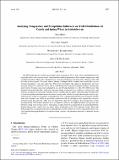| dc.contributor.author | Meng, Ting | |
| dc.contributor.author | Carew, Richard | |
| dc.contributor.author | Florkowski, Wojciech J. | |
| dc.contributor.author | Klepacka, Anna M. | |
| dc.date.accessioned | 2017-12-22T16:56:31Z | |
| dc.date.available | 2017-12-22T16:56:31Z | |
| dc.date.issued | 2017-03 | |
| dc.date.submitted | 2016-07 | |
| dc.identifier.issn | 1558-8424 | |
| dc.identifier.issn | 1558-8432 | |
| dc.identifier.uri | http://hdl.handle.net/1721.1/112935 | |
| dc.description.abstract | The IPCC indicates that global mean temperature increases of 2°C or more above preindustrial levels negatively affect such crops as wheat. Canadian climate model projections show warmer temperatures and variable rainfall will likely affect Saskatchewan's canola and spring wheat production. Drier weather will have the greatest impact. The major climate change challenges will be summer water availability, greater drought frequencies, and crop adaptation. This study investigates the impact of precipitation and temperature changes on canola and spring wheat yield distributions using Environment Canada weather data and Statistics Canada crop yield and planted area for 20 crop districts over the 1987-2010 period. The moment-based methods (full- and partial-moment-based approaches) are employed to characterize and estimate asymmetric relationships between climate variables and the higher-order moments of crop yields. A stochastic production function and the focus on crop yield's elasticity imply choosing the natural logarithm function as the mean function transformation prior to higher-moment function estimation. Results show that average crop yields are positively associated with the growing season degree-days and pregrowing season precipitation, while they are negatively affected by extremely high temperatures in the growing season. The climate measures have asymmetric effects on the higher moments of crop yield distribution along with stronger effects of changing temperatures than precipitation on yield distribution. Higher temperatures tend t o decrease wheat yields, confirming earlier Saskatchewan studies. This study finds pregrowing season precipitation and precipitation in the early plant growth stages particularly relevant in providing opportunities to develop new crop varieties and agronomic practices to mitigate climate changes. | en_US |
| dc.publisher | American Meteorological Society | en_US |
| dc.relation.isversionof | http://dx.doi.org/10.1175/JAMC-D-16-0258.1 | en_US |
| dc.rights | Article is made available in accordance with the publisher's policy and may be subject to US copyright law. Please refer to the publisher's site for terms of use. | en_US |
| dc.source | American Meteorological Society | en_US |
| dc.title | Analyzing Temperature and Precipitation Influences on Yield Distributions of Canola and Spring Wheat in Saskatchewan | en_US |
| dc.type | Article | en_US |
| dc.identifier.citation | Meng, Ting, et al. “Analyzing Temperature and Precipitation Influences on Yield Distributions of Canola and Spring Wheat in Saskatchewan.” Journal of Applied Meteorology and Climatology, vol. 56, no. 4, Apr. 2017, pp. 897–913. © 2017 American Meteorological Society. | en_US |
| dc.contributor.department | Massachusetts Institute of Technology. Department of Urban Studies and Planning | en_US |
| dc.contributor.mitauthor | Meng, Ting | |
| dc.relation.journal | Journal of Applied Meteorology and Climatology | en_US |
| dc.eprint.version | Final published version | en_US |
| dc.type.uri | http://purl.org/eprint/type/JournalArticle | en_US |
| eprint.status | http://purl.org/eprint/status/PeerReviewed | en_US |
| dc.date.updated | 2017-12-22T14:30:28Z | |
| dspace.orderedauthors | Meng, Ting; Carew, Richard; Florkowski, Wojciech J.; Klepacka, Anna M. | en_US |
| dspace.embargo.terms | N | en_US |
| mit.license | PUBLISHER_POLICY | en_US |
